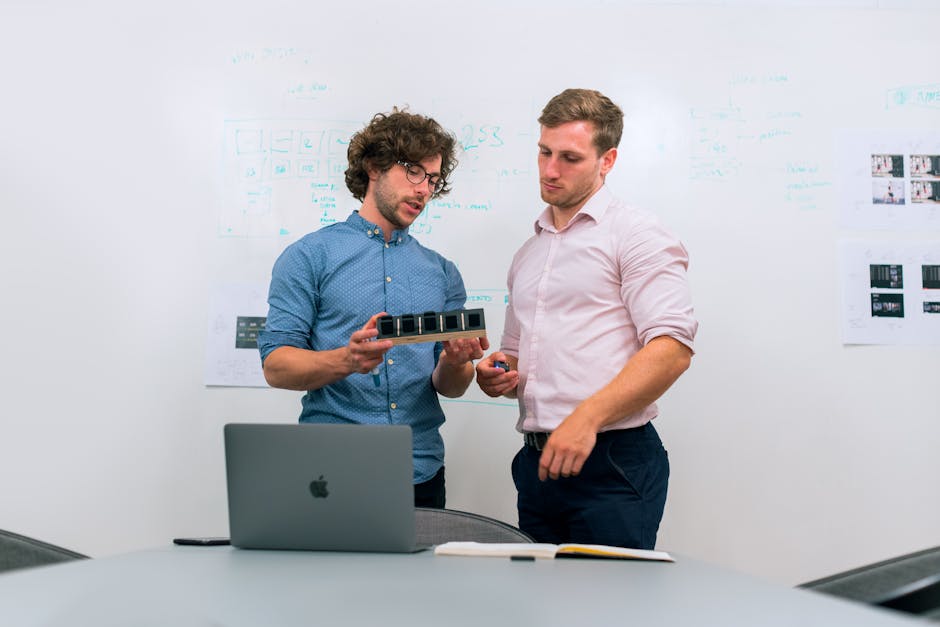Creating Competitive Edge For Leicester Start-ups With MVPs
Are you a Leicester start-up looking to gain a competitive edge in the market? Then it’s time to harness the power of Minimum Viable Products (MVPs).
By creating MVPs, you can differentiate yourself from your competitors and meet the specific needs of your target market.
In this article, we will explore how MVPs can give Leicester start-ups a strategic advantage. We will delve into the importance of differentiation and understanding user needs, as well as provide guidance on developing an effective MVP.
You’ll learn how gathering user feedback and iterating on your product or service can lead to refinement and scalability.
But it doesn’t stop there. We’ll also discuss how leveraging the competitive edge of MVPs can propel your start-up to new heights in the marketplace.
So get ready to take your Leicester start-up to the next level by creating a compelling MVP that sets you apart from the competition!
Key Takeaways
- MVPs allow Leicester start-ups to differentiate themselves from competitors and meet the specific needs of their target market.
- Understanding target markets and user needs is essential for differentiation.
- Developing an MVP involves focussing on core features that address the most pressing needs of the target market.
- Gathering user feedback and iterating on the solution are crucial for refining and scaling the product or service to gain a competitive edge.
Understanding the Importance of Differentiation

Understanding the importance of differentiation is crucial for Leicester start-ups to gain a competitive edge. In today’s saturated market, it’s not enough to simply offer a product or service; you need to stand out from the crowd.
By identifying your unique selling points (USPs), you can establish yourself as a leader in your industry and attract customers who are looking for something different.
Standing out means going beyond the ordinary and offering something that sets you apart from your competitors. It could be a new technology, an innovative business model, or even exceptional customer service. Whatever it may be, highlighting your USPs will help you create a strong brand identity and attract customers who resonate with what you have to offer.
Identifying your USPs requires careful analysis of your target market and understanding their needs. What problems do they face? How can your product or service solve those problems better than anyone else? By answering these questions, you can find ways to differentiate yourself and communicate the value you bring.
Incorporating differentiation into your business strategy will not only give you a competitive edge but also lead to increased customer loyalty and profitability. Customers are more likely to choose a company that offers something unique and valuable. So, take the time to understand what makes you different and make it an integral part of your marketing efforts.
By recognising the importance of differentiation and leveraging your unique selling points effectively, Leicester start-ups can position themselves as leaders in their respective industries. When combined with strategies for identifying target markets and user needs, this approach will pave the way for success in today’s competitive business landscape.
Identifying Target Markets and User Needs

Surprisingly, you might think you know exactly who your target market is and what they need, but let’s dig deeper to uncover new insights. Market research is a crucial step in identifying your target market and understanding their needs. By conducting thorough market research, you can gain valuable information about your potential customers, their preferences, and the problems they are looking to solve. This knowledge will enable you to create user personas that represent different segments of your target market.
To help visualise this process, let’s imagine a table with three columns: User Persona, Needs/Wants, and Pain Points. In the User Persona column, we have profiles of different individuals who could be part of your target market. In the Needs/Wants column, we outline their desires or requirements when it comes to products or services like yours. Finally, in the Pain Points column, we identify the challenges or frustrations they currently face.
By creating these user personas and mapping out their needs and pain points, you can better understand how to position your product or service as a solution that addresses those specific concerns. This targeted approach allows you to differentiate yourself from competitors by catering directly to the unique needs of your target audience.
Understanding your target market and their needs is just the first step in creating a competitive edge for Leicester start-ups with MVPs. Armed with this knowledge gained through market research and user personas, you can now move forward into developing a minimum viable product (MVP) that meets those identified needs seamlessly.
[User Persona | Needs/Wants | Pain Points]

| Young Professionals | Convenient solutions | Limited time for tedious tasks || Small Business Owners | Cost-effective options| Lack of resources for growth || Tech Enthusiasts | Cutting-edge features | Complexity in using new technology|
Now that we have a clear picture of our target audience’s expectations and pain points let’s proceed towards developing an MVP that addresses these specific requirements.
Developing a Minimum Viable Product (MVP)

Now that you’ve gained valuable insights into your target market’s needs and pain points, it’s time to dive into developing an MVP that will meet their specific requirements.
The MVP development process is a crucial step in creating a competitive edge for your Leicester start-up. By focussing on the core features and functionalities that address the most pressing needs of your target audience, you can quickly bring a product to market and gather valuable user feedback.
Developing an MVP follows a structured approach that involves identifying the key functionalities required to solve your target market’s pain points. This includes prioritising features based on their importance and impact, allowing you to deliver value quickly while minimising unnecessary development efforts.
Additionally, by working with a lean budget, you can allocate resources more efficiently and reduce the risks associated with building a fully-featured product from scratch.
The benefits of adopting an MVP approach are numerous. Firstly, it enables you to test your product hypothesis in the real world before committing significant resources to full-scale development. This reduces the chances of building a product that doesn’t resonate with your target audience or fails to meet their needs effectively.
Secondly, developing an MVP allows for rapid iteration and improvement based on user feedback, ensuring that your final product is refined and tailored to perfection.
By creating an MVP tailored specifically to address the identified pain points of your target market, you set yourself up for success in gathering user feedback and iterating on your solution. This iterative process will be covered in detail in the subsequent section about gathering user feedback and iterating without writing ‘step’.
Gathering User Feedback and Iterating

To improve your product and meet the specific needs of your target market, you should gather user feedback and iterate on your solution. User engagement is crucial in this process as it allows you to understand how your product is being perceived and used by your customers.
By actively seeking feedback from users, you can gain valuable insights into what is working well and what needs improvement. There are several methods you can use to gather user feedback. One common approach is conducting surveys or interviews with your customers, asking them about their experience with the product and their suggestions for improvement.
Another effective method is observing users in action, either through useability testing or analysing usage data. Once you have collected user feedback, it’s important to analyse it objectively and identify patterns or trends. Look for recurring themes or issues that multiple users have mentioned. This will help you prioritise which areas of your product need the most attention.
After analysing the feedback, it’s time to iterate on your solution. Make necessary changes based on the insights gathered from user feedback, and then test the new version with a small group of users before releasing it more widely. This continuous improvement cycle will ensure that your product evolves alongside the changing needs of your target market.
By gathering user feedback and iterating on your solution, you can create a product that truly meets the needs of your customers. In the next section, we will discuss how to refine and scale the product or service based on this valuable information.
Transitioning into refining and scaling the product or service, it’s important to build upon these improvements to create a competitive edge in the market.
Refining and Scaling the Product or Service

You need to take your product or service to the next level by refining and scaling it, giving you the opportunity to gain a leg up on your competition. Scaling your product or service can be challenging, but with the right strategies in place, you can overcome these obstacles and achieve success.
Here are three key points to consider:
-
Build a solid foundation: Before you can scale your product or service, it’s important to ensure that your offering is refined and optimised for maximum efficiency. This includes streamlining processes, improving customer experience, and addressing any pain points identified through user feedback.
-
Develop scalable infrastructure: As you expand your business, it’s crucial to have an infrastructure that can support increased demand. This may involve upgrading technology systems, implementing automation tools, or hiring additional staff. By investing in scalable infrastructure early on, you’ll be better equipped to handle growth and maintain quality standards.
-
Continuously iterate and improve: Scaling isn’t a one-time process; it requires ongoing refinement and improvement. Regularly assess customer needs and market trends to identify areas where your product or service can be enhanced. Use data-driven insights from user feedback and analytics to drive decision-making and prioritise development efforts.
By refining and scaling your product or service effectively, you’ll position yourself ahead of the competition.
The next section will explore how leveraging the competitive edge of MVPs can further enhance your chances of success.
Leveraging the Competitive Edge of MVPs

Leveraging the competitive advantage of MVPs can significantly enhance your chances of success in the market, providing a distinctive edge over your rivals. By optimising resources and strategically positioning yourself in the market, you can maximise the impact of your minimum viable product (MVP) and stand out from the competition.
One effective way to leverage the competitive edge of MVPs is by optimising resources. With limited time, budget, and manpower, it is crucial to focus on developing a product or service that addresses key customer pain points while minimising unnecessary features. By prioritising essential functionalities and leveraging user feedback during the development process, you can ensure that your MVP delivers value to customers while conserving resources.
Market positioning is another critical aspect when leveraging MVPs for a competitive advantage. Understanding your target audience and their specific needs allows you to position your product or service as a unique solution. Conduct market research to identify gaps in the industry and tailor your MVP accordingly. This targeted approach not only increases customer appeal but also makes it easier to differentiate yourself from competitors.
In order to convey a deeper understanding of leveraging MVPs for a competitive edge, consider using a table with three columns and four rows:
| Advantages | Disadvantages | Considerations |
| Cost-effective | Limited features | Prioritise essential functionalities |
| Faster time-to-market | Potential bugs | Incorporate user feedback |
| Customer-centric | Minimal branding | Tailor product/service based on market research |
| Competitive differentiation | Iterative development | Clearly communicate unique value proposition |
By considering these factors and effectively utilising an MVP, you can optimise resources, position yourself strategically in the market, and gain a significant competitive edge over others. Remember that successful start-ups often use their initial products as stepping stones towards future growth, so make sure to continuously refine and scale your offering based on customer feedback and market trends.
Frequently Asked Questions
How can start-ups in Leicester leverage the competitive edge of MVPs to gain an advantage over their competitors?
To gain a competitive advantage in Leicester, start-ups must leverage MVPs. By developing and testing minimum viable products, they can gather valuable customer feedback, iterate quickly, and deliver solutions that meet market demands effectively.
What are some key factors to consider when identifying target markets and user needs for Leicester start-ups?
To identify target markets and user needs for Leicester start-ups, it’s crucial to conduct thorough market research, analyse customer demographics and behaviours, and gather feedback through surveys or interviews. This will help you aline your product or service with the right audience, giving you a competitive advantage.
What are the main steps involved in developing a minimum viable product (MVP) for start-ups in Leicester?
To develop an MVP for start-ups in Leicester, you need to follow a structured process. Start by defining your goals, identifying user needs, designing the product, building a prototype, testing it with users, and iterating based on feedback.
How can start-ups in Leicester effectively gather user feedback and iterate on their MVPs to improve their products or services?
To effectively gather user feedback and iterate on your MVPs in Leicester, engage with your target audience through surveys, interviews, and useability testing. Use their insights to make informed improvements that aline with their needs and preferences.
What are some strategies that Leicester start-ups can use to refine and scale their MVPs and turn them into successful products or services?
To refine your MVP and scale it into a successful product or service, focus on gathering user feedback, iterating based on their needs, and continuously improving. Implement effective marketing strategies to drive growth and build a strong customer base.
Conclusion
Congratulations! By creating a Minimum Viable Product (MVP), you’ve unlocked the door to success for your Leicester start-up. Your MVP has the power to open up new opportunities and differentiate you from your competitors, just like a well-crafted key. It symbolises your dedication, innovation, and commitment to meeting the needs of your target market.
With user feedback guiding your every move, you can refine and scale your product or service. This will give you an unparallelled competitive edge in the market. Embrace the power of MVPs and watch as your start-up soars to new heights.
Contact us to discuss our services now!
